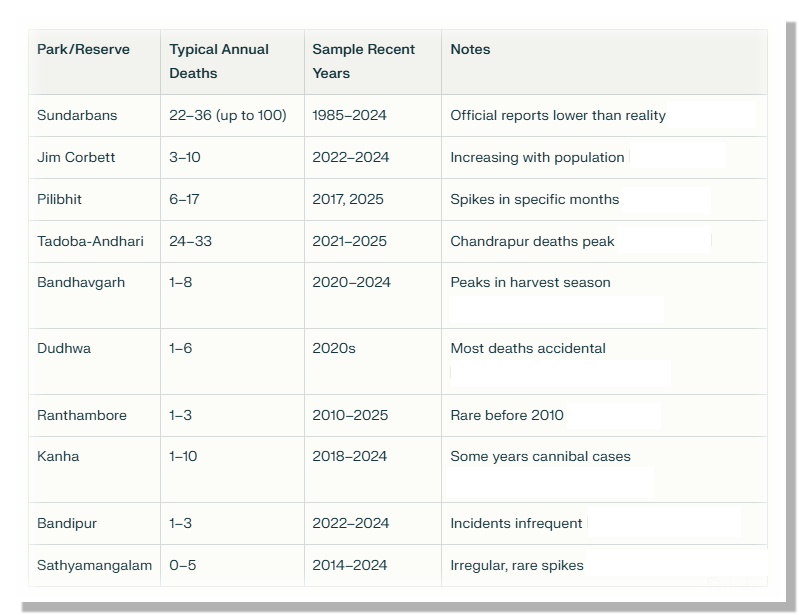Top 10 national parks in terms of maneating tigers within India
A list of top 10 national parks in terms of no of maneating tigers and no of incidents.
Key Points
The Sundarbans and Pilibhit have the highest rates of regular confirmed man-eater incidents, followed by Tadoba, Corbett, and Ranthambore.
Modern incidents typically involve elderly or injured tigers, prey base decline, or high human encroachment, with animals sometimes tranquilized or killed following attacks to prevent recurring man-eater behavior.
Underreporting is a significant issue in many regions due to the illegality of forest work and inadequate compensation mechanisms.
India’s top national parks with the most prominent history and current issues of man-eating tigers are primarily those with large tiger populations and proximity to human settlements, leading to frequent human-tiger conflict and reported cases of tigers attacking or consuming people. Below is a ranked list based on recent incidents, historical infamous man-eaters, and documented conflict rates:
Top 10 National Parks and Tiger Reserves in terms of maneaters and maneating incidents :
Sundarbans National Park (West Bengal)
Notoriously high number of fatal attacks, with annual deaths documented for decades due to tigers regularly entering villages or preying on woodcutters and fishermen.
Jim Corbett National Park (Uttarakhand)
Historical legacy of famous man-eating tigers, frequent conflicts persist with surrounding human habitations.
Pilibhit Tiger Reserve (Uttar Pradesh)
Recent spike in attacks; several cases in 2025, with tigers from forest fringes routinely entering sugarcane fields and villages.
Tadoba-Andhari Tiger Reserve (Maharashtra)
Reports of dozens of human deaths annually in recent years, especially in buffer zones with high tiger density and inadequate prey.
Bandhavgarh Tiger Reserve (Madhya Pradesh)
High tiger population density; instances of tigers attacking humans attributed to territorial disputes and habitat encroachment.
Dudhwa National Park (Uttar Pradesh)
Recorded several documented incidents of tiger attacks going back to the late 20th century, including infamous cases like Tara.
Ranthambore Tiger Reserve (Rajasthan)
Famous for man-tiger conflict caused by overpopulation and shrinking prey base, resulting in tigers straying into human areas; attacks noted in recent years.
Kanha National Park (Madhya Pradesh)
Human fatalities and livestock predation common in bordering villages due to expanding settlements and shrinking habitat.
Bandipur National Park (Karnataka)
Occasional reports of fatal tiger attacks and livestock predation due to large buffer zone population.
Sathyamangalam Tiger Reserve (Tamil Nadu)
Regularly in the news for tiger-related human fatalities and high degree of man-animal conflict due to proximity to agricultural land.
Highlights & Trends
The highest number of attacks is consistently reported from the Sundarbans and reserves with high human-tiger interface, especially where agricultural lands border core tiger habitats.
Many incidents involve old, displaced, or injured tigers venturing into human settlements out of desperation.
Territorial displacement within high-density reserves like Bandhavgarh, Kanha, and Tadoba significantly raises the risk of man-eating incidents.
These trends underscore the importance of sustained mitigation efforts, careful landscape management, and effective compensation and coexistence strategies in buffer areas.




